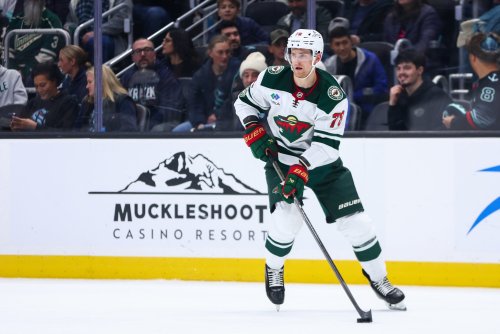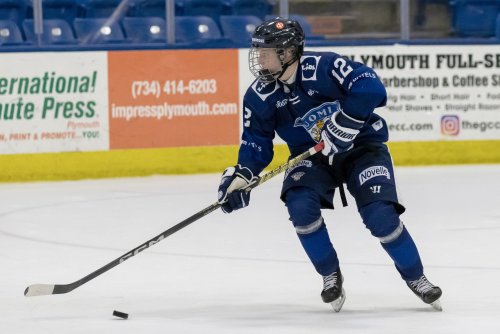.jpg.c0991f26c844860d624711c3be51ac37.jpg)
On June 27, Minnesota Wild fans will finally find out if the NHL will award hometown hero Brock Faber the second Calder Trophy in franchise history. Although phenom Connor Bedard may edge him out, there’s no question Faber had a special season.
However, the announcement of that award is more than just a personal award for Faber. It may play a small role in his inevitable extension when he’s eligible to sign on the dotted line as the new league year begins just four days later. The thing is, maybe the Wild shouldn’t be rushing to extend their star blue liner to a market-setting deal just yet.
Before the 2023-24 season even ended, tapped-in beat writer Michael Russo of The Athletic was almost preparing Wild fans for what Faber’s new AAV could be. Back in March, Russo pointed to the likes of Cale Makar ($9 million), Adam Fox ($9.5 million), and Charlie McAvoy ($9.5 million) as comparables Faber’s agents would likely seek with their client.
However, recent defensive contracts should have Faber’s camp worried their client may not become the first defenseman in Wild history to receive a contract with an AAV starting with a nine. And if the Wild want to push back on Faber’s ask, they have precedent.
Recent history is on their side if Bill Guerin and Co. choose to use it in negotiations. Over the past handful of years, there have been a plethora of extremely talented and promising young defensemen. Few have received the type of contract Faber and the Wild are seemingly negotiating following their entry-level deals.
Let’s start with the easy ones, the type of comparables Faber’s agents have little to no merit making. Makar and Fox are prominent defensemen who recently received large extensions following their ELCs. Fox signed his $9.5 million contract in November 2021, just months after he won the James Norris Trophy as the league’s best defenseman. It’s pretty fair to receive a top-of-the-market deal when the league has just declared your client the best defenseman in the world.
Makar was a slightly different story. He inked his $9 million contract in the summer of 2021, a year before winning the Norris trophy en route to also being named the Conn Smyth winner when the Colorado Avalanche secured the Stanley Cup. However, Makar was a bonafide star from the moment his skate blades touched an NHL sheet of ice, securing his Calder Trophy in 2020. Through his ELC, Makar was a point-per-game player and highly regarded as one of the best offensive blue-liners in the league.
Faber is clearly an up-and-coming defenseman, but his skill set is still a notch below Makar and Fox's. While his offensive abilities this year were a pleasant surprise, he isn’t yet the game-breaker Fox and Makar displayed during their ELCs. For those reasons, it’s a little perplexing to hear so many rumors his next deal will start in the nines.
However, Makar and Fox were not the only young defensemen who received long deals after their ELCs expired. Other notable blue-chip defenseman, such as Miro Heiskanen, Quinn Hughes, and Jake Sanderson, recently signed long extensions. Hughes was the first, signing for $7.85 million for only six years. His comparison is a little harder to draw from because Hughes’ deal came during the COVID pandemic. The uncertainty of the world climate led his team to look for a slightly shorter term at a lower cap hit.
But it helped set the standard for defensemen looking to secure the bag following their ELC. Unless you are in the stratosphere of the absolute best at your position, a huge extension should benefit the player and the team. In this scenario, the contract should benefit the player immediately, as they are likely paid slightly higher than their current value. Yet the team is banking on your skill set, expanding to the point the contract is a good deal for the team toward the end of it (see: Matt Boldy).
Heiskanen and Sanderson are prime examples of this line of thinking. Heiskanen signed his 8-year, $8.45 million AAV contract in the summer of 2021. At the time, Heiskanen had not proven himself as an offensive force. However, the Dallas Stars were willing to sign him to such a long contract as they hoped to be on the positive side of that deal as he got older. They have reaped the benefits of that gamble. The Finnish star exploded into a true two-way impact player in the third year of that contract.
Sanderson signed for eight years at $8.05 million AAV following his lone full season in the NHL, similar to where Faber stands now. But Sanderson was a former 5th overall pick and already a staunch player in his own end. Just like Dallas with Heiskanen, the Ottawa Senators understand they are probably overpaying him now and hoping the offensive side of his game develops to the point he becomes a part of future Norris Trophy ballots.
These four comparisons point to a world where Faber should not receive an AAV in nines this summer. His accomplishments after one season don’t compare to that of Makar or Fox. Faber is in a much more similar position to Heiskanen and Sanderson.
He’s a great player. However, he has some deficiencies in his game -- he is not a powerplay threat and cannot walk the blue line of the offensive zone -- that the top defensemen don’t have. Why would it make sense to pay a player a top-of-the-market deal when he isn’t quite there yet?
I would argue that a long-term deal doesn’t make nearly as much sense as a bridge deal for the Wild. It’s an idea that hasn’t been rumored for Faber but has proved valuable to other teams with a stud defenseman and minimal cap space.
Probably the best comparison for Faber, in both style of play and contract situation, is Boston Bruins’ defenseman Charle McAvoy. Following his ELC in 2019, McAvoy signed a three-year, $4.9 million bridge deal. He was already regarded as a stout defenseman in his own zone but lacked the offensive talent to warrant a top-of-the-market deal.
However, McAvoy has developed into one of the best all-around defensemen in the league. With one year remaining on that bridge deal, Boston offered an eight-year, $9.5 million contract. The deal was beneficial to the player and the team. McAvoy was awarded life-changing money as he worked to become a more complete player, and Boston didn’t have to gamble on a player with a large contract they hoped he would live up to.
Why can’t this be the right strategy for Faber and the Wild? Faber exploded onto the scene this year with an offensive touch hardly anyone saw coming. We should praise his 47 points combined with above-average defense in his own zone. However, it wasn’t too long ago that Faber's college team left him off the power play. Who to say this one-year outburst wasn’t a fluke?
Let me be clear, I don’t think it was a fluke. But even with offensive production like that, Faber’s output paled compared to those with contracts in the nines and above. Where Faber is now in his development, his next contract should align with Heiskanen or Hughes, not Makar and Fox. That means that, at most, an eight-year contract for $8-$8.5 million makes the most sense. Or, if Faber truly believes he deserves to be paid amongst the elites, he would be better off signing a 2-3 year bridge deal and securing a contract that approaches $10 million on his next contract.
Regardless of his route, the Wild would be wise to stand firm on these negotiations. The precedent doesn’t call for Faber to receive $9 million. And every dollar counts for a team trying to build a roster around their star in Kirill Kaprizov.
Think you could write a story like this? Hockey Wilderness wants you to develop your voice, find an audience, and we'll pay you to do it. Just fill out this form.
-
 4
4








Recommended Comments
Join the conversation
You can post now and register later. If you have an account, sign in now to post with your account.
Note: Your post will require moderator approval before it will be visible.